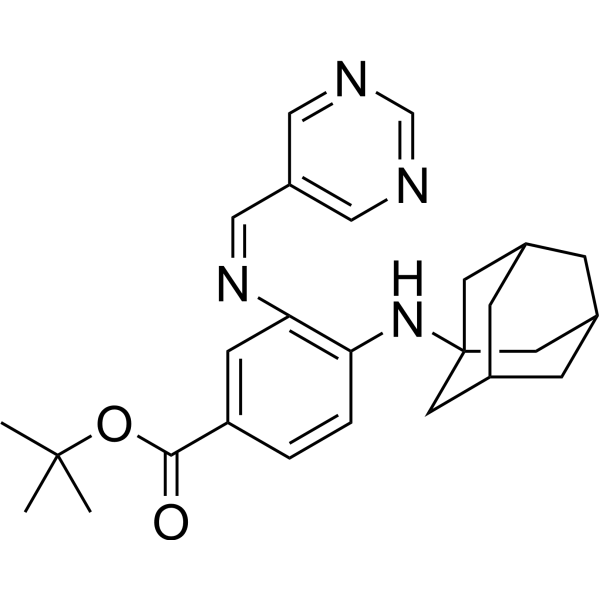Physicochemical Properties
| Molecular Formula | C26H32N4O2 |
| Molecular Weight | 432.56 |
| Exact Mass | 432.252 |
| CAS # | 1793052-96-6 |
| PubChem CID | 91801200 |
| Appearance | Yellow to orange solid powder |
| Density | 1.3±0.1 g/cm3 |
| Boiling Point | 614.9±55.0 °C at 760 mmHg |
| Flash Point | 325.7±31.5 °C |
| Vapour Pressure | 0.0±1.8 mmHg at 25°C |
| Index of Refraction | 1.656 |
| LogP | 4.93 |
| Hydrogen Bond Donor Count | 1 |
| Hydrogen Bond Acceptor Count | 6 |
| Rotatable Bond Count | 7 |
| Heavy Atom Count | 32 |
| Complexity | 668 |
| Defined Atom Stereocenter Count | 0 |
| InChi Key | DFENTOUMMDWZAF-UHFFFAOYSA-N |
| InChi Code | InChI=1S/C26H32N4O2/c1-25(2,3)32-24(31)21-4-5-22(23(9-21)29-15-20-13-27-16-28-14-20)30-26-10-17-6-18(11-26)8-19(7-17)12-26/h4-5,9,13-19,30H,6-8,10-12H2,1-3H3 |
| Chemical Name | tert-butyl 4-(1-adamantylamino)-3-(pyrimidin-5-ylmethylideneamino)benzoate |
| HS Tariff Code | 2934.99.9001 |
| Storage |
Powder-20°C 3 years 4°C 2 years In solvent -80°C 6 months -20°C 1 month Note: This product requires protection from light (avoid light exposure) during transportation and storage. |
| Shipping Condition | Room temperature (This product is stable at ambient temperature for a few days during ordinary shipping and time spent in Customs) |
Biological Activity
| ln Vitro | In both the presence and absence of erastin, SRS16-86 (1 μM) reduces ferroptosis in HT-1080 cells and NIH 3T3 cells for a duration of 24 hours [2]. |
| ln Vivo | Mice treated with SRS16-86 (intraperitoneal injection, 2 mg/kg; 15 minutes prior to surgery) are protected against both structural organ damage and functional acute renal failure after ischemia-reperfusion injury (IRI) [2]. When it came to avoiding renal IRI, SRS16-86 (ip; 2 mg/kg; 4 weeks) in combination with [Nec-1+SfA] was more effective than [Nec-1+SfA] dual therapy. In the plasma of IRI mice models, the addition of SRS16-86 can lower serum urea and serum creatinine levels [2]. Rats with spinal cord injuries who receive an intraperitoneal injection of SRS16-86 (15 mg/kg, once daily for seven days) had reduced levels of inflammatory adhesion factors and pro-inflammatory cytokines in their injured spinal cords [3]. |
| Animal Protocol |
Animal/Disease Models: Renal IRI model Doses: 2 mg/kg; 15 min before the onset of surgery Route of Administration: intraperitoneal (ip)injection; 2 mg/kg; 15 min before the onset of surgery Experimental Results: Was protective from renal IRI. Animal/Disease Models: Renal IRI model Doses: 2 mg/kg Route of Administration: Combination with Necrostatin-1/Sanglifehrin A; 2 mg/kg; 4 weeks Experimental Results: Further increased the protective effect of [Necrostatin-1/Sanglifehrin A] combination therapy in renal IRI model. |
| References |
[1]. Novel Ferroptosis Inhibitors with Improved Potency and ADME Properties. J Med Chem. 2016 Mar 10;59(5):2041-53. [2]. Synchronized renal tubular cell death involves ferroptosis.Proc Natl Acad Sci U S A. 2014 Nov 25;111(47):16836-41. [3]. Ferroptosis inhibitor SRS 16-86 attenuates ferroptosis and promotes functional recovery in contusion spinal cord injury. Brain Res. 2019 Mar 1;1706:48-57. |
| Additional Infomation | SRS16-86 is an ethyl ester resulting from the formal condensation of the carboxy group of 4-[(adamantan-1-yl)amino]-3-{(Z)-[(pyrimidin-5-yl)methylidene]amino}benzoic acid with tert-butanol. It is an inhibitor of ferroptosis induced by erastin in HT-1080 and NIH3T3 cells when used at a concentration of 1 muM. It has a role as a ferroptosis inhibitor. It is a tert-butyl ester, a member of adamantanes, a member of pyrimidines, a substituted aniline, a secondary amino compound and an imine. |
Solubility Data
| Solubility (In Vitro) | DMSO : 33.33 mg/mL (77.05 mM) |
| Solubility (In Vivo) |
Solubility in Formulation 1: ≥ 2.5 mg/mL (5.78 mM) (saturation unknown) in 10% DMSO + 40% PEG300 + 5% Tween80 + 45% Saline (add these co-solvents sequentially from left to right, and one by one), clear solution. For example, if 1 mL of working solution is to be prepared, you can add 100 μL of 25.0 mg/mL clear DMSO stock solution to 400 μL PEG300 and mix evenly; then add 50 μL Tween-80 to the above solution and mix evenly; then add 450 μL normal saline to adjust the volume to 1 mL. Preparation of saline: Dissolve 0.9 g of sodium chloride in 100 mL ddH₂ O to obtain a clear solution. Solubility in Formulation 2: 2.5 mg/mL (5.78 mM) in 10% DMSO + 90% (20% SBE-β-CD in Saline) (add these co-solvents sequentially from left to right, and one by one), suspension solution; with ultrasonication. For example, if 1 mL of working solution is to be prepared, you can add 100 μL of 25.0 mg/mL clear DMSO stock solution to 900 μL of 20% SBE-β-CD physiological saline solution and mix evenly. Preparation of 20% SBE-β-CD in Saline (4°C,1 week): Dissolve 2 g SBE-β-CD in 10 mL saline to obtain a clear solution. Solubility in Formulation 3: ≥ 0.83 mg/mL (1.92 mM) (saturation unknown) in 10% DMSO + 90% Corn Oil (add these co-solvents sequentially from left to right, and one by one), clear solution. For example, if 1 mL of working solution is to be prepared, you can add 100 μL of 8.3 mg/mL clear DMSO stock solution to 900 μL of corn oil and mix evenly. (Please use freshly prepared in vivo formulations for optimal results.) |
| Preparing Stock Solutions | 1 mg | 5 mg | 10 mg | |
| 1 mM | 2.3118 mL | 11.5591 mL | 23.1182 mL | |
| 5 mM | 0.4624 mL | 2.3118 mL | 4.6236 mL | |
| 10 mM | 0.2312 mL | 1.1559 mL | 2.3118 mL |
